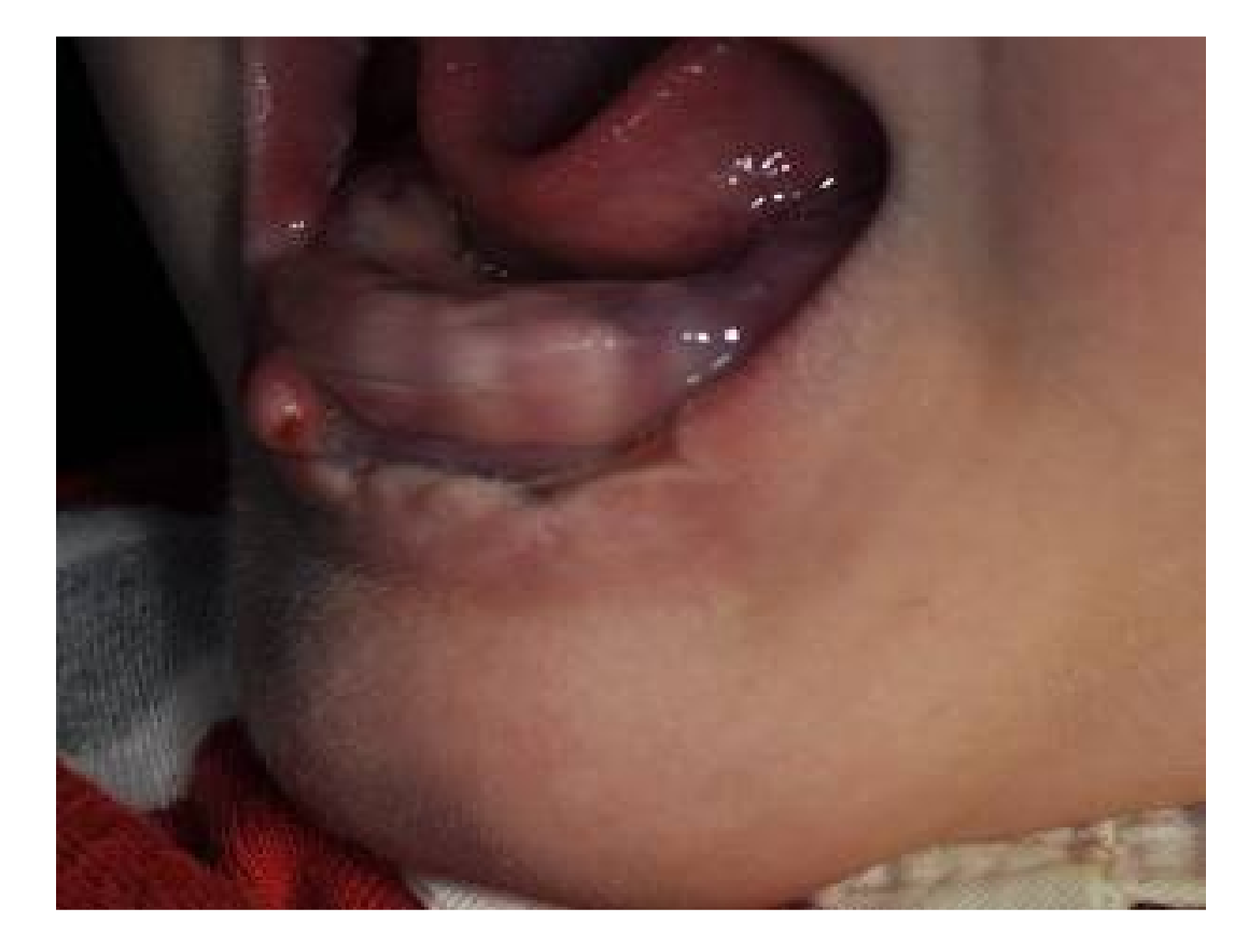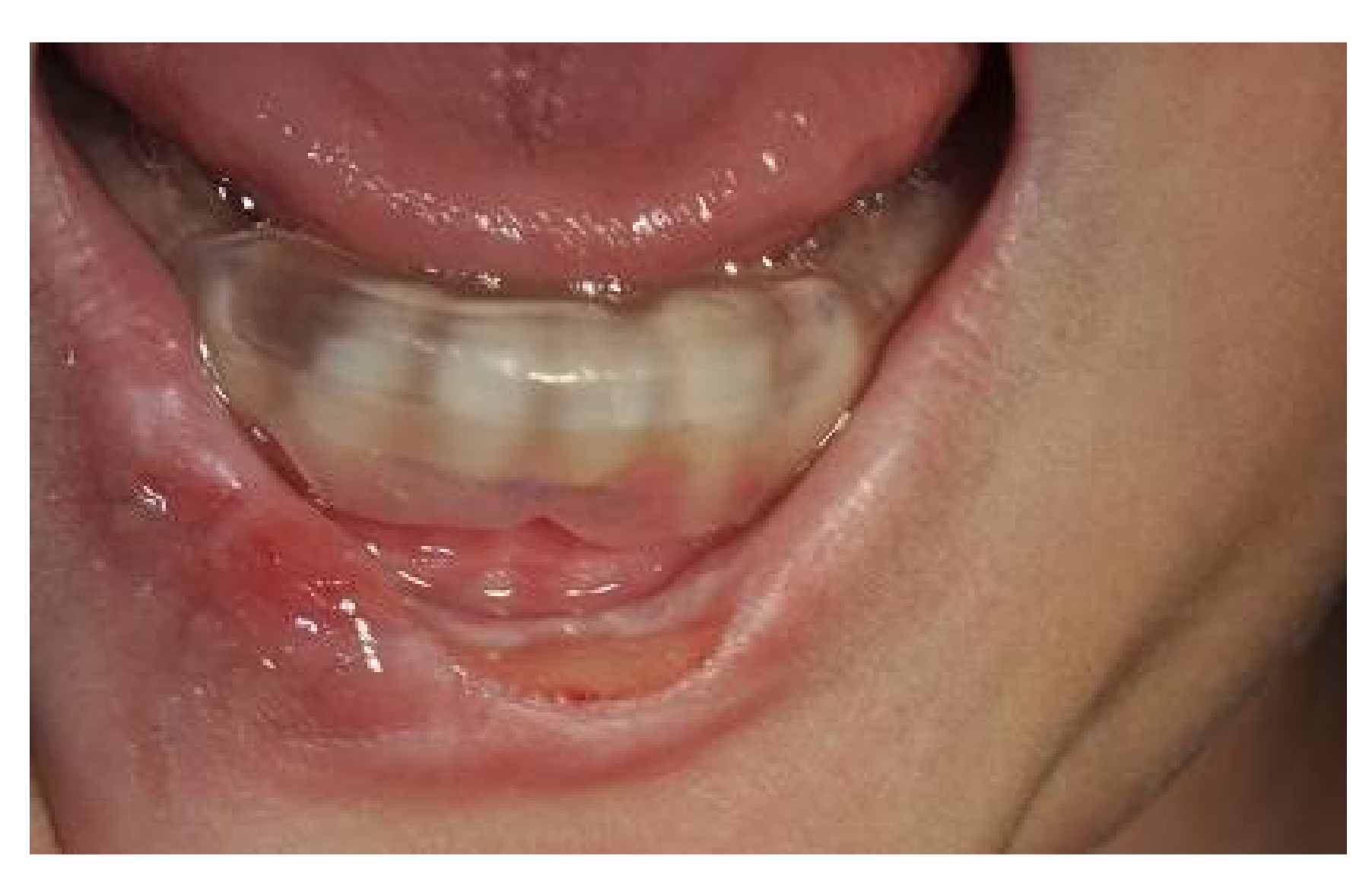Management and Prevention of Oral Self-Injuries in Lesch–Nyhan Syndrome
Abstract
:1. Introduction
2. Case Presentation Section
3. Discussion
4. Conclusions
Author Contributions
Conflicts of Interest
References
- Seegmiller, J.E.; Rosenbloom, F.M.; Kelly, W.N. Enzyme defect associated with a sex-linked human neurological disorder and excessive purine synthesis. Science 1967, 155, 1682–1684. [Google Scholar] [CrossRef] [PubMed]
- Lesch, M.; Nyhan, W.L. A familiar disorder of uric acid metabolism and central nervous system function. Am. J. Med. 1964, 36, 561–570. [Google Scholar] [CrossRef]
- Shoptaw, J.T.; Reznik, J.I. Lesch–Nyhan syndrome: Report of three cases in one family. J. Dent. Child. 1978, 45, 403–407. [Google Scholar]
- Bundick, J. Lesch–Nyhan syndrome. J. Dent. Child. 1969, 36, 277–280. [Google Scholar]
- Nyhan, W.L. The Lesch–Nyhan syndrome. Annu. Rev. Med. 1973, 24, 41–60. [Google Scholar] [CrossRef] [PubMed]
- Fernald, C.D. The Lesch–Nyhan syndrome: Cerebral palsy, mental retardation, and self mutilation. J. Pediatr. Psychol. 1976, 1, 51–55. [Google Scholar] [CrossRef]
- Nyhan, W.L. Behavior in the Lesch Nyhan syndrome. J. Autism Child. Schizophr. 1976, 6, 235–252. [Google Scholar] [CrossRef] [PubMed]
- Scully, C. The orofacial manifestations of the Lesch–Nyhan syndrome. Int. J. Oral Surg. 1981, 10, 380–383. [Google Scholar] [CrossRef]
- Steadman, R.H.; McIntosh, G. Lesch-Nyhan syndrome. J. Oral Maxillofac. Surg. 1982, 40, 750–752. [Google Scholar] [CrossRef]
- Dicks, J.L. Lesch–Nyhan syndrome: A treatment-planning dilemma. Paediatr. Dent. 1982, 4, 127–130. [Google Scholar]
- Newcombe, D.S. Treatment of X-linked primary hyperuricemia with allopurinol. JAMA 1966, 198, 315–317. [Google Scholar] [CrossRef] [PubMed]
- Baumeister, A.A.; Frye, G.D. The biochemical basis of the behavioral disorder in the Lesch–Nyhan syndrome. Neurosci. Biobehav. Rev. 1985, 9, 169–178. [Google Scholar] [CrossRef]
- Van Moffaert, M. Management of self-mutilation. Psychother. Psychosom. 1989, 51, 180–186. [Google Scholar] [CrossRef] [PubMed]
- Olson, L.; Houlihan, D. A review of behavioral treatments used for Lesch–Nyhan syndrome. Behav. Modif. 2000, 24, 202–222. [Google Scholar] [CrossRef] [PubMed]
- Roach, P.S.; Delgado, M.; Anderson, L.; Iannaccone, S.T.; Burns, D.K. Carbamazepine trial for Lesch–Nyhan self-mutilation. J. Child Neurol. 1996, 11, 476–478. [Google Scholar] [CrossRef] [PubMed]
- Gutierrez, C.; Pellene, A.; Micheli, F. Botulinum toxin: Treatment of self-mutilation in patients with Lesch–Nyhansyndrome. Clin. Neuropharmacol. 2008, 31, 180–183. [Google Scholar] [CrossRef] [PubMed]
- Dabrowski, E.; Smathers, S.A.; Ralstrom, C.S.; Nigro, M.A.; Leleszi, J.P. Botulinum toxin as a novel treatment for self-mutilation in Lesch–Nyhan syndrome. Dev. Med. Child Neurol. 2005, 47, 636–639. [Google Scholar] [PubMed]
- Budnick, J. The Lesch–Nyhan syndrome. ASDC J. Dent. Child. 1967, 36, 277–280. [Google Scholar]
- Deon, L.L.; Kalichman, M.A.; Booth, C.L.; Slavin, K.V.; Gaebler-Spira, D.J. Pallidal deep-brain stimulation associated with complete remission of self-injurious behaviors in a patient with Lesch–Nyhan syndrome: A case report. J. Child. Neurol. 2012, 27, 117–120. [Google Scholar] [CrossRef] [PubMed]
- Piedimonte, F.; Andreani, J.C.; Piedimonte, L.; Micheli, F.; Graff, P.; Bacaro, V. Remarkable clinical improvement with bilateral globus pallidus internus deep brain stimulation in a case of Lesch–Nyhan disease: Five-year follow-up. Neuromodulation 2015, 18, 118–122. [Google Scholar] [CrossRef] [PubMed]



© 2018 by the authors. Licensee MDPI, Basel, Switzerland. This article is an open access article distributed under the terms and conditions of the Creative Commons Attribution (CC BY) license (http://creativecommons.org/licenses/by/4.0/).
Share and Cite
Caserta, G.; Defabianis, P. Management and Prevention of Oral Self-Injuries in Lesch–Nyhan Syndrome. Reports 2018, 1, 8. https://doi.org/10.3390/reports1010008
Caserta G, Defabianis P. Management and Prevention of Oral Self-Injuries in Lesch–Nyhan Syndrome. Reports. 2018; 1(1):8. https://doi.org/10.3390/reports1010008
Chicago/Turabian StyleCaserta, Giuliana, and Patrizia Defabianis. 2018. "Management and Prevention of Oral Self-Injuries in Lesch–Nyhan Syndrome" Reports 1, no. 1: 8. https://doi.org/10.3390/reports1010008




